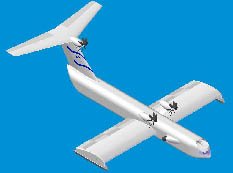SlickDriver
ACCESS: Confidential
- Joined
- 20 June 2006
- Messages
- 161
- Reaction score
- 33
From Techion University Haifa Israel
The final configuration of the WIG is a combination of two turbo-fan and three turbo-prop engines, with the turbo-fan engines only being activated during take-off. This engines configuration was derived from low fuel consumption and high flight range requirements. This configuration, which was chosen out of three, was the best because it gives the longest range for the WiG. The turbo-fan engines (HK-32) were locataed in such a manner that the diffusers would be found inside the fuselage above the cockpit (so that the aircraft flow facing area and shape drag would decrease, and the engines would be protected from water spray) and the nozzles would direct the engines jets to the lower wing surface generating an air cushion. As the project objective definition was cargo aircraft design, fuselage configuration was dictated mainly by payload requirements. Maximal payload (in 60 ton fuel take-off configuration) was defined as 120 ton in standard aviation containers of two types: LD3 and ALP containers.
The final configuration of the WIG is a combination of two turbo-fan and three turbo-prop engines, with the turbo-fan engines only being activated during take-off. This engines configuration was derived from low fuel consumption and high flight range requirements. This configuration, which was chosen out of three, was the best because it gives the longest range for the WiG. The turbo-fan engines (HK-32) were locataed in such a manner that the diffusers would be found inside the fuselage above the cockpit (so that the aircraft flow facing area and shape drag would decrease, and the engines would be protected from water spray) and the nozzles would direct the engines jets to the lower wing surface generating an air cushion. As the project objective definition was cargo aircraft design, fuselage configuration was dictated mainly by payload requirements. Maximal payload (in 60 ton fuel take-off configuration) was defined as 120 ton in standard aviation containers of two types: LD3 and ALP containers.

